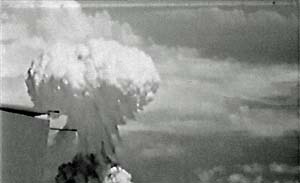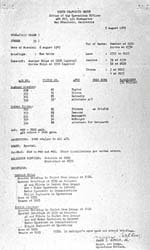One of my favorite documents in the Hoover Archives is not a museum-quality piece of art or a rare document penned by one of history’s leading characters. It is an innocuous-looking government document—the ordnance manifest for a bombing run on August 6, 1945. The order, pulled from a military bulletin board, eventually made its way to the Hoover Institution Archives, where it now resides.
Signed by James I. Hopkins Jr., an unknown major, the strike order indicates only that the ordnance that the flight will be carrying is “special.” The special bomb turned out to be a twenty-kiloton atomic bomb that obliterated Hiroshima, Japan.
Why do I find this footnote to history so fascinating? In and of itself, it is not. But it heralded the nuclear age—the determining element of U.S. foreign policy for the next half century. That piece of paper not only led to the bombing, the capitulation of Japan, and the end of World War II but reduced world and economic leadership to two: the United States and the Soviet Union. These two countries soon plunged headlong into a Cold War, characterized by increased nuclear proliferation and threats, that ultimately contributed to the bankruptcy of the Soviet Union.
 The Hiroshima explosion as seen from the Great Artiste, the instrument plane that accompanied the Enola Gay on its bombing mission. The 16-mm film was donated to the Hoover Institution Archives by Harold Agnew, a physicist who monitored the bombing from the Great Artiste. The first atomic explosion made an indelible impression on those who witnessed it. As Robert Lewis, the copilot of the Enola Gay, remarked, “If I live a hundred years, I’ll never quite get these few minutes out of my mind.” The Hiroshima explosion as seen from the Great Artiste, the instrument plane that accompanied the Enola Gay on its bombing mission. The 16-mm film was donated to the Hoover Institution Archives by Harold Agnew, a physicist who monitored the bombing from the Great Artiste. The first atomic explosion made an indelible impression on those who witnessed it. As Robert Lewis, the copilot of the Enola Gay, remarked, “If I live a hundred years, I’ll never quite get these few minutes out of my mind.” |
The success of the Manhattan Project, apart from its military implications, signified the ascendance of science. The arms race, the space race, the Star Wars defense program—not to mention nuclear power and jet propulsion—all became possible when policymakers acknowledged the unlimited capacity of the human mind and the ability of man to achieve the previously inconceivable.
Although the devastation wrought by the bomb was mind-boggling, what followed the bomb was an equally astonishing sea change: the end of one war and the start of another, the beginning of the nuclear age, the transformation of two military powers into economic powers (Japan and Germany), and, within two years, the beginning of the baby boom.








